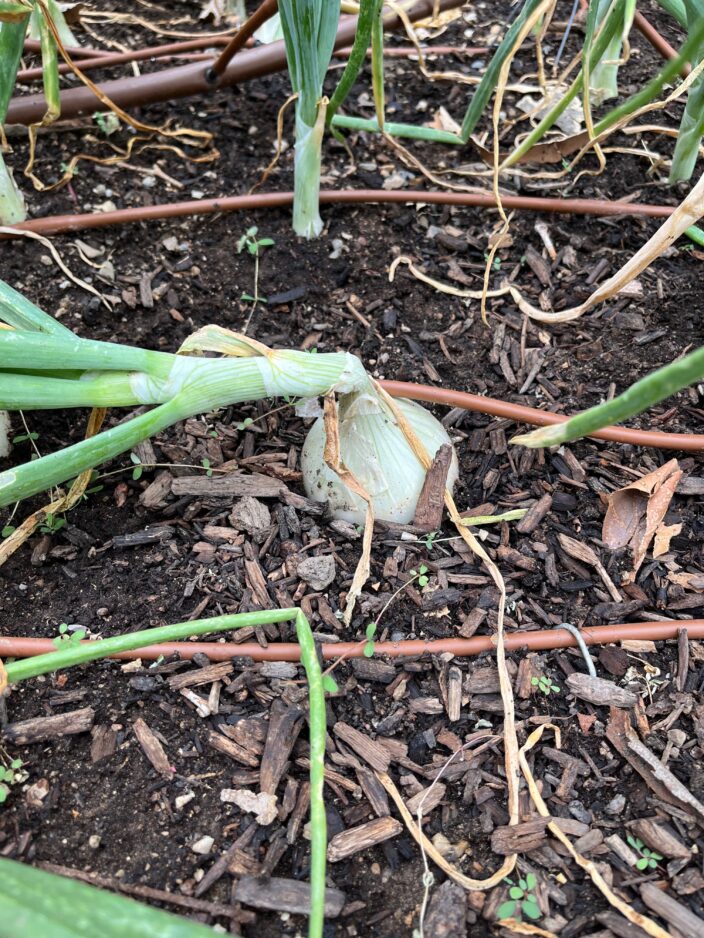Garden Help Desk: How do I know when my onions are ready to harvest?

Courtesy photo
Onions can be harvested and eaten as soon as they look large enough, but for storage onions, the plants need time to mature. Wait until you see more than just a few onion tops falling over and you'll have onions that can store well through the winter or beyond.
Is it time to harvest my onions? The tops on few of my plants have started to fall over.
It sounds like your onions might benefit from another week or so in the garden before harvesting. Once you see about that 50-60% of the tops have fallen over you can start harvesting your onions and getting them cured for storage. If you’re growing more than one variety, you may find that one variety is ready to harvest days or even a few weeks before another variety.
Cut back on their watering once you decide your onions are getting close to harvest. When you are ready to harvest, don’t cut back the green tops. It’s also best if you don’t just pull the onions, because that may damage the foliage at the neck of the onion and provide an entry point for fungi and bacteria that can cause decay during storage. Instead of pulling by hand, carefully lift the onions with a spading fork, or with a shovel if you don’t have a spading fork. Avoid damaging the bulbs while you lift the onions.
You can leave your onions on top of the soil in the garden while the tops dry out, but you should make sure the green tops will shade the bulbs to prevent sun burn that can damage the outer layer.
If you don’t have enough tops on your onions to protect the bulbs, or you just don’t want to leave your onions out in the garden to dry, you can bring them into a shaded area with good air circulation while they dry.

Courtesy Meredith Seaver
Each onion variety matures on its own schedule. These onion varieties were planted at the same time. The onions on the left are ready for harvest, but the variety on the right needs more time to mature.
If your onions are ready for harvest but you don’t have time to get into the garden to do that you can leave the onions in the ground after the tops fall over, but you should stop watering them so that they don’t start to regrow. Then just lift the onions and let them finish drying when you can.
Whichever option you choose for drying your onions, make sure they are protected from rain and sprinkler water, especially if you are harvesting later in the gardening season. The drying time is an important step because the green tops on your onions need to dry out completely before you cut or break them away at the neck. You can remove the tops once they’re completely dry and brush off any loose dirt, but don’t remove the papery layers on the outside of the onions. Those layers serve as natural wrapper that will protect the storage life of the onion. You can also trim away the dried roots on your onions if you’d like, but it isn’t necessary.
Put your onions in mesh bags or well-ventilated boxes for storage. They don’t need to be kept in the dark, but a cold, dry area will give onions their best quality and longest storage life. They can take a light frost, but temperatures below 30 degrees Fahrenheit can damage the onions so be cautious about keeping them in an uninsulated shed or garage during the winter.
I started my first cut flower garden this year. The flowers seem to fade faster than I expected after I bring them in and put them in vases. What can I do to keep them looking good for more than a day or two?
Cutting gardens require consistent care and attention, so you certainly want to get the most out of your efforts. Here are some tips.

Courtesy photo
There are many cutting flowers that do very well in our local gardens. With good care and the best harvesting practices, cut flowers will be fresh and beautiful for many days.
Cut your flowers in the morning while temperatures are cooler. Using sharp scissors or clippers, cut young, fresh flowers with the longest stem possible and put the flowers immediately into the bucket of cool water that you carry with you each time you harvest.
Take your cut flowers indoors promptly to keep them cool and let them sit in a cool place, out of direct sunlight to hydrate for a while before you arrange your blooms in vases.
Recutting the stems while the ends are submerged in a basin of water can help to preserve their quality, especially for stems that crushed or damaged during cutting.
Change the water in your vases and recut the stems every few days.
Give purchased flowers the same care- purchase early in the day if you can, take them home promptly to get them out of the car before running other errands. Recut the stems if the flowers aren’t already in an arrangement and keep the water fresh.
- Onions can be harvested and eaten as soon as they look large enough, but for storage onions, the plants need time to mature. Wait until you see more than just a few onion tops falling over and you’ll have onions that can store well through the winter or beyond.
- Each onion variety matures on its own schedule. These onion varieties were planted at the same time. The onions on the left are ready for harvest, but the variety on the right needs more time to mature.
- There are many cutting flowers that do very well in our local gardens. With good care and the best harvesting practices, cut flowers will be fresh and beautiful for many days.






